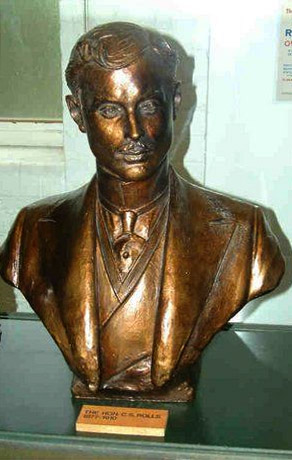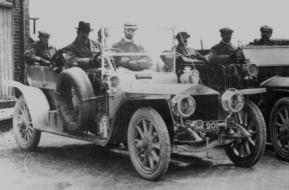|
Peugeot Type 15
The Peugeot Type 15 was an early Peugeot model built from 1897 to 1901. Its production run of 276 vehicles was the highest by the company up to that point, and in excess of all previous models combined. Engine Peugeot ended its Daimler partnership and produced their first in-house engine for this car, made in their recently built Audincourt factory. Their transversely mounted flat-twin was a departure from this prior foreign-made V-twin engine. It produced 8 bhp. Famous owners Charles Rolls, who collaborated with Henry Royce to found the famous Rolls-Royce marque in 1906, owned a Peugeot Type 15 and established a dealership in Britain selling Peugeot and other French cars in 1902. Alberto Santos-Dumont Alberto Santos-Dumont (self-stylised as Alberto Santos=Dumont; 20 July 1873 – 23 July 1932) was a Brazilian aeronaut, sportsman, inventor, and one of the few people to have contributed significantly to the early development of both lighter-t ... purchased a Type 15 ... [...More Info...] [...Related Items...] OR: [Wikipedia] [Google] [Baidu] |
Peugeot
Peugeot (, , ) is a French automobile brand owned by Stellantis. The family business that preceded the current Peugeot companies was established in 1810, making it the oldest car company in the world. On 20 November 1858, Émile Peugeot applied for the lion trademark. Armand Peugeot (1849–1915) built the company's first vehicle, a Steam car, steam-powered tricycle. In 1886, the company collaborated with Léon Serpollet, followed by the development of an internal combustion car in 1890, which used a Panhard-Daimler-Motoren-Gesellschaft, Daimler engine. The Peugeot family and company are originally from Sochaux, where Peugeot still operates a large manufacturing facility and the Musée de l'Aventure Peugeot, Peugeot Museum. Peugeot vehicles have received numerous international accolades, including six European Car of the Year awards. The brand also boasts over a century of success in motorsport, with victories including the Indianapolis 500 in 1913, 1916, and 1919. Peugeot Spo ... [...More Info...] [...Related Items...] OR: [Wikipedia] [Google] [Baidu] |
Charles Rolls
Charles Stewart Rolls (27 August 1877 – 12 July 1910) was a British motoring and aviation pioneer. With Henry Royce, he co-founded the Rolls-Royce Limited, Rolls-Royce car manufacturing firm. He was the first Briton to be killed in an aeronautical accident with a powered aircraft, when the tail of his Wright Model A, Wright Flyer broke off during a flying display in Bournemouth. He was aged 32. Early life Rolls was born in Berkeley Square, London, third son of John Rolls, 1st Baron Llangattock, the 1st Baron Llangattock of the Rolls family and Lady Llangattock. Despite his London birth, he retained a strong family connection with his ancestral home, The Hendre, a English country house, country house near Monmouth in Monmouthshire (historic), Monmouthshire in the South East Wales, south-east of Wales. After attending Mortimer Vicarage Preparatory school (UK), Preparatory School in Berkshire, he was educated at Eton College where his developing interest in engines earned him ... [...More Info...] [...Related Items...] OR: [Wikipedia] [Google] [Baidu] |
Rear-engined Vehicles
In automobile design, a rear-engine design layout places the engine at the rear of the vehicle. The center of gravity of the engine itself is behind the rear axle. This is not to be confused with the center of gravity of the whole vehicle, as an imbalance of such proportions would make it impossible to keep the front wheels on the ground. Rear-engined vehicles almost always have a rear-wheel drive car layout, but some are four wheel drive. This layout has the following features: *Packaging: since there is no need for a transmission tunnel, the floor can be flat. *Rear traction: having the engine located over the driven wheels increases downward pressure, which is helpful for grip on loose surfaces, although can be prone to oversteer. *Simplicity of manufacture: the engine is near the driven wheels, and the transmission can be merged with the differential to save space. This layout was once popular in small, inexpensive cars and light commercial vehicles. Today most car makers ... [...More Info...] [...Related Items...] OR: [Wikipedia] [Google] [Baidu] |
Peugeot Vehicles
Peugeot (, , ) is a French automobile brand owned by Stellantis. The family business that preceded the current Peugeot companies was established in 1810, making it the oldest car company in the world. On 20 November 1858, Émile Peugeot applied for the lion trademark. Armand Peugeot (1849–1915) built the company's first vehicle, a Steam car, steam-powered tricycle. In 1886, the company collaborated with Léon Serpollet, followed by the development of an internal combustion car in 1890, which used a Panhard-Daimler-Motoren-Gesellschaft, Daimler engine. The Peugeot family and company are originally from Sochaux, where Peugeot still operates a large manufacturing facility and the Musée de l'Aventure Peugeot, Peugeot Museum. Peugeot vehicles have received numerous international accolades, including six European Car of the Year awards. The brand also boasts over a century of success in motorsport, with victories including the Indianapolis 500 in 1913, 1916, and 1919. Peugeot Spo ... [...More Info...] [...Related Items...] OR: [Wikipedia] [Google] [Baidu] |
Timeline Of Most Powerful Production Cars
This list of most powerful production cars in the world is limited to unmodified production cars which meet the eligibility criteria below. All entries must verified from reliable sources. Eligible cars Because of inconsistencies in the definitions of production cars, dubious claims by manufacturers and self-interest groups, and inconsistent or changing application of definitions, this list has a defined set of requirements. For explanation of how these were determined, see the links above. For the purposes of this list, a production car is defined as a vehicle that conforms to at least one of the following two definitions: (A.) # Constructed principally for retail sale to consumers for their personal use, and to transport people on public roads (no commercial or industrial vehicles are eligible) # Had 25 or more instances made by the original vehicle manufacturer and offered for commercial sale to the public in new condition (cars modified by either professional tuners or i ... [...More Info...] [...Related Items...] OR: [Wikipedia] [Google] [Baidu] |
Alberto Santos-Dumont
Alberto Santos-Dumont (self-stylised as Alberto Santos=Dumont; 20 July 1873 – 23 July 1932) was a Brazilian aeronaut, sportsman, inventor, and one of the few people to have contributed significantly to the early development of both lighter-than-air and heavier-than-air aircraft. The heir of a wealthy family of coffee producers, he dedicated himself to aeronautical study and experimentation in Paris, where he spent most of his adult life. He designed, built, and flew the first powered airships and won the Deutsch prize in 1901, when he flew around the Eiffel Tower in his airship No. 6, becoming one of the most famous people in the world in the early 20th century. Santos-Dumont then progressed to powered heavier-than-air machines and on 23 October 1906 flew about 60 metres at a height of two to three metres with the fixed-wing '' 14-bis'' (also dubbed the —"bird of prey") at the Bagatelle Gamefield in Paris, taking off unassisted by an external launch system. On 12 Novem ... [...More Info...] [...Related Items...] OR: [Wikipedia] [Google] [Baidu] |
Marque
A brand is a name, term, design, symbol or any other feature that distinguishes one seller's goods or service from those of other sellers. Brands are used in business, marketing, and advertising for recognition and, importantly, to create and store value as brand equity for the object identified, to the benefit of the brand's customers, its owners and shareholders. Brand names are sometimes distinguished from Generic brand, generic or store brands. The practice of branding—in the original literal sense of marking by burning—is thought to have begun with the ancient Egyptians, who are known to have engaged in livestock branding and branded slaves as early as 2,700 BCE. Branding was used to differentiate one person's cattle from another's by means of a distinctive symbol burned into the animal's skin with a hot branding iron. If a person stole any of the cattle, anyone else who saw the symbol could deduce the actual owner. The term has been extended to mean a strategic person ... [...More Info...] [...Related Items...] OR: [Wikipedia] [Google] [Baidu] |
Rolls-Royce Limited
Rolls-Royce Limited was a British luxury car and later an aero-engine manufacturing business established in 1904 in Manchester by the partnership of Charles Rolls and Henry Royce. Building on Royce's good reputation established with his Crane (machine), cranes, they quickly developed a reputation for superior engineering by manufacturing luxury cars. The business was incorporated as "Rolls-Royce Limited" in 1906, and a new factory in Derby was opened in 1908. The First World War brought the company into manufacturing aero-engines. Joint development of jet engines began in 1940, and they entered production in 1944. Rolls-Royce has since built an enduring reputation for the development and manufacturing of engines for military and commercial aircraft. In the late 1960s, Rolls-Royce was adversely affected by the mismanaged development of its advanced Rolls-Royce RB211, RB211 jet engine and consequent cost over-runs, though it ultimately proved a great success. In 1971, the owners w ... [...More Info...] [...Related Items...] OR: [Wikipedia] [Google] [Baidu] |
Henry Royce
Sir Frederick Henry Royce, 1st Baronet (27 March 1863 – 22 April 1933) was an English engineer famous for his designs of car and aeroplane engines with a reputation for reliability and longevity. With Charles Rolls (1877–1910) and Claude Johnson (1864–1926), he founded Rolls-Royce. Rolls-Royce initially focused on large 40–50 horsepower motor cars, the Silver Ghost and its successors. Royce produced his first aero engine shortly after the outbreak of the First World War, and aircraft engines became Rolls-Royce's principal product. Royce's health broke down in 1911, and he was persuaded to leave his factory in the Midlands at Derby and, taking a team of designers, move to the south of England spending winters in the south of France. He died at his home in Sussex in the spring of 1933. Early life Royce was born in Alwalton, Huntingdonshire, near Peterborough on 27 March 1863 to Mary (née King) and James Royce.Reese, pp. 17-22, 24-27 He had four older siblings, Emily ... [...More Info...] [...Related Items...] OR: [Wikipedia] [Google] [Baidu] |
V-twin
A V-twin engine, also called a V2 engine, is a two-cylinder piston engine where the cylinders are arranged in a V configuration and share a common crankshaft. The V-twin is widely associated with motorcycles, primarily installed longitudinally, though also transversely. They are also used in a variety of other land, air, and marine vehicles, as well as industrial applications. The V-twin design dates back to the late 1880s. Origins One of the first V-twin engines was built by Gottlieb Daimler in 1889. It was used as a stationary engine, for boats and in the Daimler Stahlradwagen ("steel-wheeled car"), Daimler's second car. The engine was also manufactured under licence in France by Panhard et Levassor. An early V-twin engined motorcycle was produced in November 1902 by the Princeps AutoCar Company in the United Kingdom. The following year, V-twin motorcycles were produced by Eclipse Motor & Cycle Co in the United Kingdom (the ''XL-ALL'' model), Glenn Curtiss in the United ... [...More Info...] [...Related Items...] OR: [Wikipedia] [Google] [Baidu] |
Audincourt
Audincourt () is a commune in the Doubs department in the Bourgogne-Franche-Comté region in eastern France. History Audincourt belonged to the County of Montbéliard which became part of France in 1793, during the French Revolutionary Wars. Population Economy An iron foundry was established early in the nineteenth century to refine the ore from the rich mines near Bethoncourt. Personalities * Daniel Beretta, retired voice actor * Alassane N'Diaye, footballer * Camel Meriem, footballer * Irène Tharin, politician See also * Communes of the Doubs department The following is a list of the 563 communes of the Doubs department of France. The communes cooperate in the following intercommunalities (as of 2025): References External links [...More Info...] [...Related Items...] OR: [Wikipedia] [Google] [Baidu] |
Flat-twin
A flat-twin engine is a two-cylinder internal combustion engine with the cylinders on opposite sides of the crankshaft. The most common type of flat-twin engine is the boxer-twin engine, where both pistons move inwards and outwards at the same time. The flat-twin design was patented by Karl Benz in 1896 and the first production flat-twin engine was used in the ''Lanchester 8 hp Phaeton'' car released in 1900. The flat-twin engine was used in several other cars since, however a more common usage is in motorcycles; early models oriented the cylinders in line with the frame, however later models switched to the cylinders being perpendicular to the frame to provide even cooling across both cylinders. Flat-twin engines were also used in several aircraft up until the 1930s and in various stationary applications from the 1930s to the 1960s. The Australian lawnmower manufacturer Victa also produced a flat-twin engine push mower from August 1975 to 1980 dubbed the ‘Twin 500’, and lat ... [...More Info...] [...Related Items...] OR: [Wikipedia] [Google] [Baidu] |










